No products in the cart.
March 21
苦味 (にがみ) : Nigami / Bitter
0 comments
Each article augments Japanese words throughout its text. The vocabulary throughout the text is related to cooking, food, and flavor. Below each block of text will be a drop down menu that contains the meaning and reading of each word, Like this:
和食(わしょく) is a cuisine loved by people all over the world. Yet, most people don't know how to cook 和食 because they don't understand the 食材料(しょくざいりょう)in Japanese recipes.
和食(わしょく)
"Wa-shoku" – Japanese cuisine
和:わ:Japanese style; harmony
食:しょく:eat; food
食材料(しょくざいりょう)
"shokuzai-ryō"– ingredients
食:しょく:food; eat
材:ざい:lumber
料:りょう:materials
This dropdown menu can be used in your preferred study method. We recommend that you attempt to read through each section first without revealing the word meanings, and make educated guesses based on context clues. Then, reveal the word meanings and read the section once more using the drop list for reference.
This is of course completely up to you, as you might prefer to read each drop list first, before reading each section. There are no right or wrong ways to use this tool, although we DO suggest that you use some form of memorization. So try to keep the words hidden for as long as possible, or go off of memory or context for as long as you can, and don't be afraid to read a section more than once!
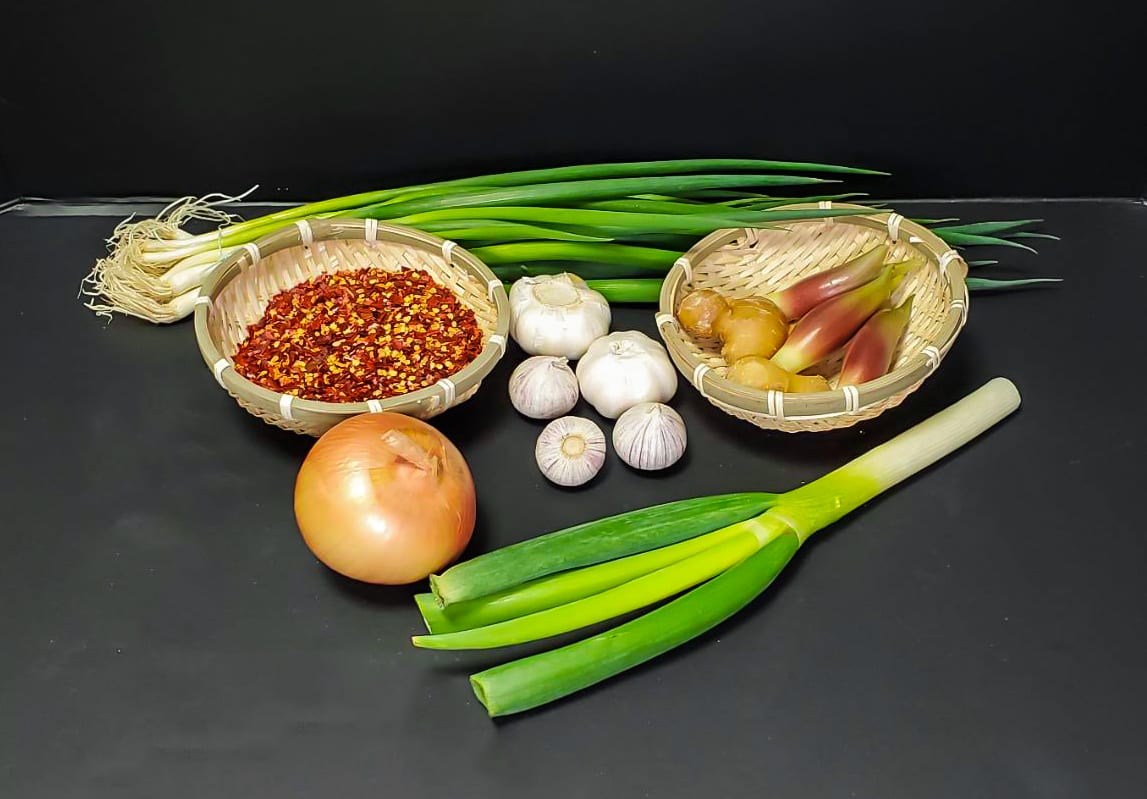
If there was ever an unsung hero of 味付け(あじとけ), then 苦味 would be it. Most of us don't have fond childhood memories of drinking black coffee in the morning, or coming home for dinner to Mom's famous kale salad. Being the socially learned, acquired taste that it is, 苦味 isn't exactly on the top of every kid's list of favorite flavors. Ever wonder why it's so hard to make a 7 year old eat his vegetables? Too bitter, that's why. They're not sweet like cookies and choccy milk, or pleasantly sour like strawberries, or rich and salty like chicken nuggies. Sorry, King, but you're going to have to learn to like black coffee the way Mommy girlfriend does.
See, pure 苦味 is often rough on the palate. Bring up the subject of Okinawan cuisine with Japanese people and quite a few of them stick their tongues out in disgust. Those with more refined palates may appreciate the pungent taste of the ゴーヤ, also called 苦瓜(にがうり), used so heavily throughout this regional cuisine. Even with steamy 玉子(たまご)and the rich 醤油(しょうゆ)to temper it, this writer will admit it can leave an aftertaste that's particularly hard to shake.
But without this rugged bad boy of a flavor profile, life wouldn't nearly as rich. In the right amounts, with the right flavors and aromatics to balance it out, 苦味 can be the element of a recipe sorely missed if left out of a recipe. Imagine a world where the only kind of chocolate on the shelves was that of the white variety. That would be WAY too sweet, overly rich, and inevitably boring. How about savory stews, steaks, and tomato sauces without garlic to unify all of the flavors? That would be a very sad state of affairs.
味付け(あじつけ)
"aji-tsuke" – flavor development
味:あじ:flavor; taste
付け:つけ:to add; to join; to fix
ゴーヤ(苦瓜(にがうり))
"goya" – bitter melon; bitter gourd
玉子(たまご)
"tamago" – egg(s)
玉:たま:ball
子:ご:child; seed
醤油(しょうゆ)
"shōyu" – soy sauce
醤:しょう:a kind of miso
油:ゆ:oil
Unlike the other flavor profiles which are drawn primarily from 調味料(ちょうみりょう), 苦味 is the flavor profile most prevalent in 野菜(やさい). Noxious gas might make you you tear up when you cut into 玉ねぎ(たまねぎ), but no 炒め料理(いためりょうり)is complete without its bitter crunch. Raw にんにく(大蒜)is quite overbearing if eaten on it own, but who doesn't love it added to a 出汁(だし), or incorporated into 肉料理(にくりょうり)?
Fresh ハーブ like みょうが(茗荷), 青じそ(あお紫蘇)and せり(芹)complete a dish by adding their robust 香り(かおり)to a finished recipe. But without profiles like 酸味 and 甘味 to balance them out, they're just overwhelming to the palate. しょうが(生姜)is yet another variation of 苦味 used throughout 和食(わしょく)in both its 生(なま)and cooked forms. As a root 野菜, it stands up well to the heat of a 出汁 or an 炒め, becoming more mild as its 苦さis tempered by the heat.
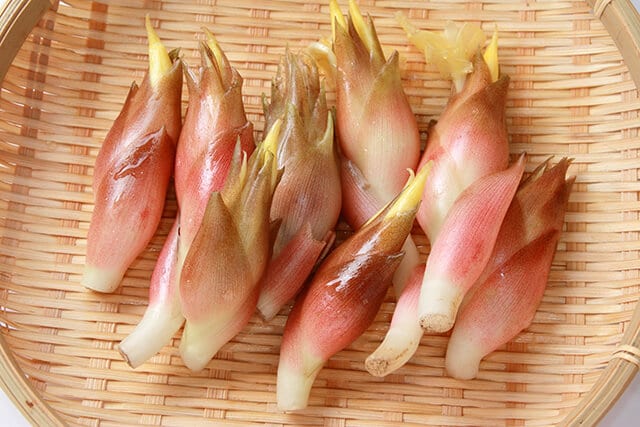
みょうが
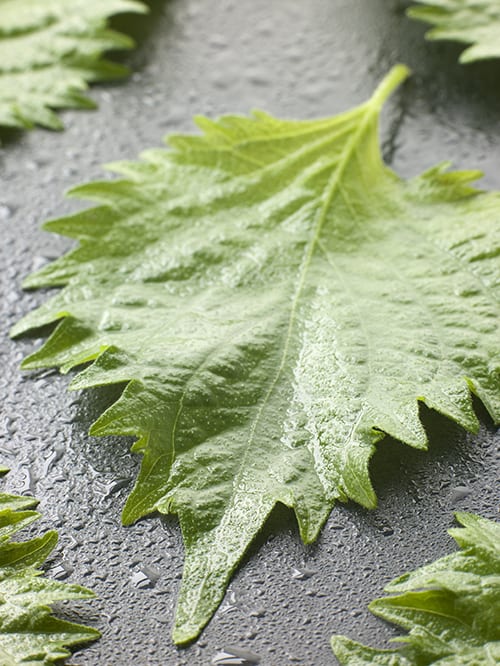
あおじそ
We know from the article on 酸味 that contrast is king in 料理, and this is exactly what 苦味 brings to a dish. Perhaps even more so than 酸味, 苦味 acts as a foil for other flavors, drawing them out and making them prevalent against it. Much like its acidic cousin, 苦味 provides a sort of relief to the palate albeit in a different way. While 酸味balances flavors in a dish, 苦味 pronounces all the flavors of a dish by providing contrast against the otherwise overbearing 甘さ(あまさ), 塩っぱさ(しょっぱさ), and 酸っぱさ(すっぱさ).
調味料(ちょうみりょう)
"chō-mi-ryō" – condiments
調:ちょう:tune; tone; arrange
味:み:flavor; taste
料:りょう:materials; fee
野菜(やさい)
"yasai" – vegetable
野:や:plains; field; rustic
菜:さい:vegetables; greens
玉ねぎ(たまねぎ)
"tama negi" – onion
玉:たま:ball
ねぎ:葱:onion
炒め料理(いためりょうり)
"itame ryōri" – stir fried dish
炒め:いため:stir fry; saute (noun form)
料:りょう:materials; fee
理:り:logic; reason; arrangement
にんにく(ニンニク、蒜)
"nin-niku" – garlic
だし(出汁)
"dashi" – a Japanese broth made from fish and kelp
だ:出:to come out of
し:汁:soup; juice
肉料理(にくりょうり)
"niku ryōri" – meat dish
肉:にく:meat; flesh
料:りょう:materials; fee
理:り:logic; reason; arrangement
ハーブ
"hāb" – herbs
みょうが(茗荷)
"myōga" – Japanese ginger (Zingiber mioga)
みょう:茗:tea
が:荷:baggage; cargo
青じそ(あお紫蘇)
"aojiso" – perilla leaves
青:あお:blue
紫:じ:purple
蘇:そ:revived
*green and tasty – neither blue, nor purple, and certainly not revived
せり(芹)
香り(かおり)
"kaori" – aromatic; fragrance
しょうが(生姜)
"shōga" – ginger
しょう:生:raw; life
が:姜:ginger
和食(わしょく)
"Washoku" – Japanese cuisine
和:わ:Japanese style; harmony
食:しょく:eat; food
生(なま)
"nama" – raw; life
甘さ(あまさ)
"amasa" – sweetness (noun)
塩っぱさ(しょっぱさ)
"shoppasa" – saltiness (noun)
酸っぱさ(すっぱさ)
"suppasa" – sourness; noun
As explained in this article, each flavor receptor in the human mouth was evolutionarily designed to serve a different function by detecting both essential and potentially dangerous properties of food. In no other flavor profile is this truer than in 苦味. In terms of harm avoidance, 苦味 flavor receptors developed to detect potential 毒性(どくせい)in the wild. Poisonous substances are often bitter, and these receptors evolved to be repulsed by overly pungent substances. That explains the strong aversion to purely 苦い flavors, which is often only tempered through social learning. Not many people start out enjoying black coffee and hoppy beer, and yet both are widely enjoyed by a mostly older crowd.
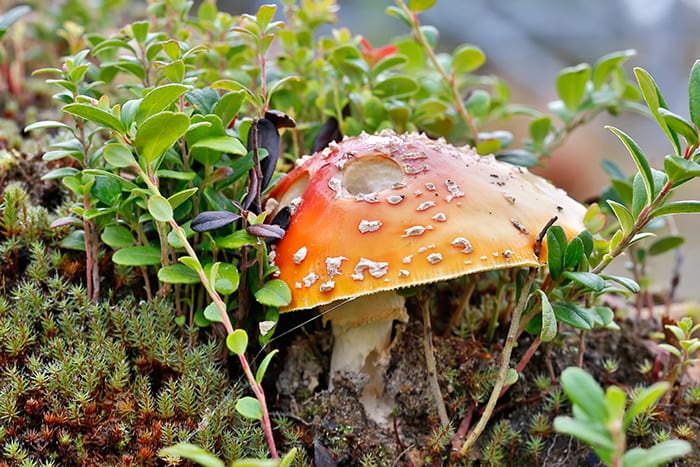
BEWARE!
Alternatively, 苦い foods are often rich in vitamins, minerals, and antioxidants, which explains why 野菜, 豆(まめ)and お茶(おちゃ) are so 苦い. These 栄養(えいよう)are very important to the human body and so through social learning, we learn to like them. It's no wonder most children refuse to eat their vegetables: we're designed as a species to be wary of the 味 they're so high in! (By the way, for all you true geniuses out there, vitamins, minerals, and antioxidants translate to ビタミン, 成分(せいぶん), and 抗酸化物質(こうさんかぶっしつ). Just keep in mind that with the exception of 「ビタミン」, most 日本人(にほんじん)don't even use those other words...)
抹茶(まっちゃ)is the perfect representation of this, perhaps even more so than コーヒー. If you love the Japanese お菓子(おかし)that its used in, then you probably already know what 抹茶 is – the form of Japanese green tea leaves ground into a fine powder and either brewed in お湯(おゆ)or used in lattes, ice cream, and cakes. If you've never drank it straight, then you may NOT know just how damn 苦い it is. You also may not know that it's incredibly high in all sorts of those micronutrients mentioned above.
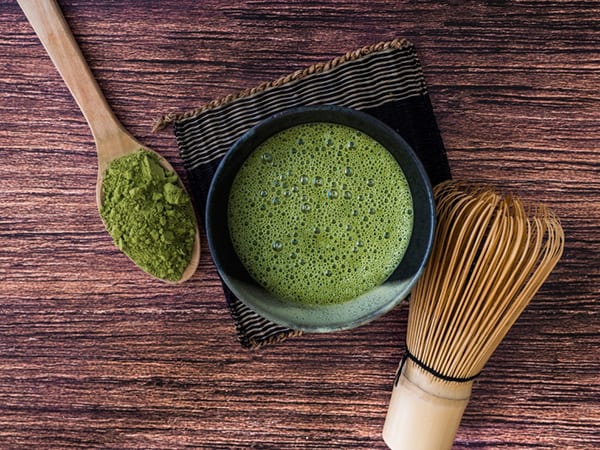
Personally this writer prefers a simple cup of the black, but you can't argue with the 科学(かがく) and the 栄養学(えいようがく)behind all of it.
毒性(どくせい)
"dokusei" – toxic; poisonous
毒:どく:poison; germ
性:せい:essential nature; gender
豆(まめ)
"mame" – beans; legumes
お茶(おちゃ)
"o'cha" – green tea
栄養(えいよう)
"eiyō" – nutrition; nutrients
栄:えい:flourish; prosperity
養:よう:foster; bring up; rear
ビタミン
"bitamin" – vitamins
成分(せいぶん)
"seibun" – component; ingredient; (essential items)
成:せい:to become
分:ぶん:part; portion
抗酸化物質(こうさんかぶっしつ)
"kōsan kabu-shitsu" – antioxidants
抗:こう:confront; resist; defy; oppose
酸:さん:acid; sour
化:か:change; take the form of
物:ぶつ:thing; object
質:しつ:substance; quality; matter
日本人(にほんじん)
"nihon-jin" – Japanese person; Japanese national
日:に:day; sun; Japan
本:ほん:book; main; true
人:じん:person
抹茶(まっちゃ)
"matcha" – powdered green tea
抹:まっ:rub; paint
茶:ちゃ:tea
お菓子(おかし)
"okashi" – confection; snacks
菓:か:fruit; candy; cakes
子:し:child
お湯(おゆ)
"oyu" – hot water; bath
科学(かがく)
"kagaku" – science
科:か:department; course
学:がく:study; learning
栄養学(えいようがく)
"eiyo gaku" – nutritional science
栄:えい:flourish; prosperity
養:よう:foster; bring up; rear
学:がく:study; learning
You could say 辛味(からみ)is a subcategory of 苦味, the spicy offshoot unfortunately unrepresented in 和食. It's true that the 辛味 present in 和食 doesn't quite hold up to the gochujang pepper pastes of 韓国料理(かんこくりょうり)used to make stews and to ferment the 漬け物(つけもの) like kimchi that put 韓国料理 on the map. However, that doesn't mean its completely absent from 和食, or that it's any less 美味い(うまい)when it is incorporated.
There are several forms of 辛味 which can add a pleasant kick to your dish. The most basic and well known of them all is 唐辛子(とうがらし), which comes in different variations. 青唐辛子(あおとうがらし)is the standard version used in different cuisines all over the world. Referred to as both 生 and 青(あお*), these fresh peppers can be hard to come by in standard スーパー, especially out of season. If you manage to fine your way to a large enough 道の駅(みちのえき)in the 田舎(いなか)however, and you might be delighted by a treasure trove of some of the most vibrant, colorful, ass kicking 青唐辛子 you've ever seen, sold out of big crates.
辛味(からみ)
"karami" – spicy flavor profile
韓国料理(かんこくりょうり)
"Kankoku ryōri" – Korean cuisine
漬け物(つけもの)
"tsukemono" – pickled foods
漬:つけ:pickling; soak
物:もの:thing; object
美味い(うま・い)
"umai" – delicious
美:beautiful
味:flavor; taste
唐辛子(とうがらし)
"tōgarashi" – chilli peppers
唐:とう:T'ang; China
辛:がら:spicy
子:し:child
青唐辛子(あおとうがらし)
"ao tōgarashi" – fresh chilli peppers
青:あお:blue; green
唐:とう:T'ang; China
辛:がら:spicy
子:し:child
スーパー
"sūpā" – supermarket
道の駅(みちのえき)
"michi no eki" – roadside farmer's market; lit. "road station"
道:みち:road; path
駅:えき:station
田舎(いなか)
"inaka" – countryside
田舎:いなか:field; countryside
*these kanji have different readings when broken down
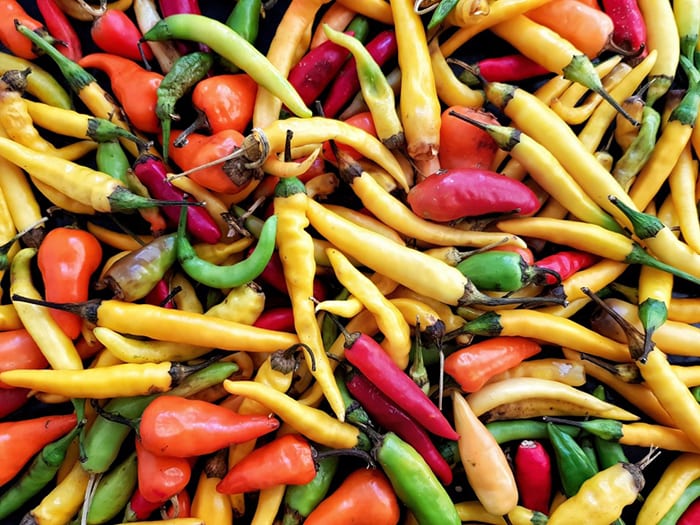
In its dried form, 唐辛子 is transformed into 一味(いちみ)唐辛子, which is the standard pepper flake found in 和食. Alternatively, dried 唐辛子 will often be incorporated into a larger spice mix called 七味(しちみ). This mix is comprised of various spices which both enhance and are enhanced by the 唐辛子 used as its base. Theses spices vary by region and vendor, but often include 山椒(さんしょう), some sort of 柑橘(かんきつ) such as 柚子(ゆず), ごま(胡麻), as well as others.
Perhaps the most renowned form of 辛味 in the 和食 catalogue is the わさび(山葵)eaten with 寿司(すし) and 刺身(さしみ). This Japanese variant of horseradish probably needs no introduction, as almost every 寿司 fan experience its infamous sinus-clearing head rush. What most don't know is that most わさび on the market is not true wasabi, but rather a substitute based on horseradish and food coloring. The authentic version of it is ground over graters made from dried shark's skin and is a much paler green than its common supermarket 偽物(にせもの). As it's fairly difficult to mass-cultivate, the real deal is rather expensive, and found only in higher end 寿司屋(すしや)around Japan.
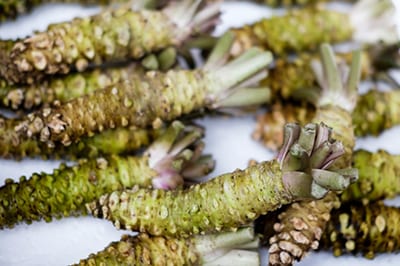
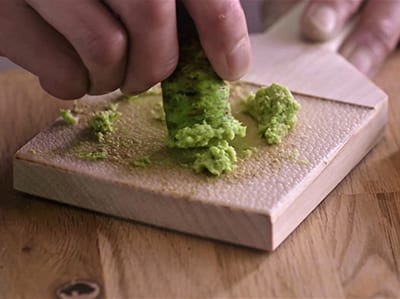
一味(いちみ)
"ichi-mi" – single pepper spice
一:いち:one
味:み:flavor; taste
七味(しちみ)
"shichi-mi" – blend of seven spices
七:しち:seven
味:み:flavor; taste
山椒(さんしょう)
"sanshō" – Japanese pepper (Zanthoxylum piperitum)
山:さん:mountain
椒:しょう:Zanthoxylum piperitum
橘(かんきつ)
"kankitsu" – citrus
柑:かん:citrus; orange
橘:きつ:mandarin orange
ゆず(柚子)
"yuzu" – a species of Japanese citrus, yellow in color
ゆ:柚:citron
ず:子:child
胡麻(ごま)
"goma" – sesame
胡:ご:foreign; barbarian
麻:ま:hem; flax
わさび(山葵)
"wasabi" – wasabi (sometimes called "Japanese horseradish")
*these kanji have different readings when broken down
寿司(すし)
"sushi" – anything made with vinegared rice
寿:す:longevity
司:し:director
刺身(さしみ)
"sashimi" – raw fish
刺:さ・し:pierce; stab
身:み:body
偽物(にせもの)
"nisemono" – fake; imposter
偽:にせ:false
物:もの:thing
寿司屋(すしや)
"sushi-ya" – sushi restaurant
寿:す:longevity
司:し:director
屋:や:shop; store; dealer

View of Tropical lagoon of Ishigaki island
You can't talk about 苦味 in the Japanese lexicon without delving into the regional cuisine of 沖縄(おきなわ). This sub-tropical archipelago in the southwest corner of Japan is home to turquoise blue waters, vibrant coral reefs, palms that sway in the breeze, and some of the most bitter stir-fries known to man. 沖縄 is known to be one of the happiest places to live, as its locals enjoy not only fabulous weather, but also one of the highest average living standards and longest life expectancies. It boasts about 35 centenarians for every 100,000 people, with an average life expectancy of around 84 years.
With most of their diet consisting of 野菜 and 豆(まめ), they must being doing something right. As mentioned above, perhaps the most famous 苦味 present in 沖縄料理 is the bitter melon ゴーヤ. It's used in 炒め料理(いためりょうり), salads, and steamed dishes. Another lesser recognized form of 苦味 is that of 豆腐(とうふ). It's used throughout 和食, but more heavily in 沖縄料理, particularly in the various チャンプルー along with ゴーヤ. チャンプルー is a kind of 炒め料理 specific to 沖縄, and is made in a variety of ways with different ingredients.
沖縄(おきなわ)
"Okinawa" (Japan's most southwestern prefecture / island chain)
沖:おき:open sea
縄:なわ:straw rope; cord
豆(まめ)
"mame" – beans; legumes
炒め料理(いためりょうり)
"itame ryōri" – stir fried dish
豆腐(とうふ)
"tōfu" – tofu
豆:とう:beans
腐:ふ:rot; decay
チャンプルー
"chanpurū" – Okinawan stir fry; (Okinawan for 'a mix of things')
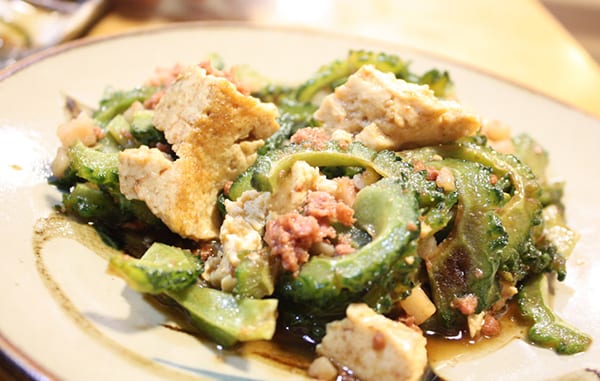
This is チャンプルー
Fun fact: チャンプルー is a word from Okinawan dialect that means "things mixed together". The famous anime (Samurai Champloo) is a direct reference to this. The anime is set in the 江戸時代(えどじだい) of old world Japan, but also features a fantastical mix of modern day hip hop culture. From the amazing soundtrack which featured the incredibly talented late producer Nujabes, to the break-dancing inspired fighting style of one of the three protagonists, チャンプルー is indeed the word to describe such an eccentric mix of influences.

This is also チャンプルー
Furthermore, the word チャンプルー was chosen over say, 「炒め」because (MINOR SPOILER ALERT) the aforementioned breakdancing samurai hails from the 琉球(りゅうきゅう)islands. During this time, exiled prisoners were sent 沖縄, originally called 琉球, to live out their lives among other criminals. This character Mugen was the son of said criminals, a feral product of his wild environment, and a former pirate. You might say he live quite a 苦い existence up until destiny crossed his path with the other two protagonists Jin and Fuu.
江戸時代(えどじだい)
"Edo Jidai" – The Edo Period of Japan's national history
江戸:Edo (the historical name of Tōkyō)
江:え:inlet; bay
戸:ど:door
時代:era; period; generation
時:じ:time; hour
代:だい:age; era
琉球(りゅうきゅう)
"Ryūkyū" – Historical name of Formerly independent Okinawan Kingdom
琉:りゅう:lapis lazuli (precious stone)
球:きゅう:ball; sphere

As if 沖縄料理 wasn't abundant enough in its use of 苦味, they managed to turn some of the sharpest liquor the entire country has to offer into 調味料... by mixing it with 唐辛子. It's called コーレーグス, and it's a real kick to the teeth.
To make コーレーグス, the locals take ripping hot 唐辛子, and they soak it in a regional alcohol called 泡盛(あわもり). 泡盛 is very strong – like, 60 - 120 proof strong. With a high enough alcohol content, this stuff is flammable. The 唐辛子 is then usually left to soak for at least 10 days, at which point it can be used as a tabletop condiment to add a 辛い(からい)shot of 苦味 to a dish. We've had it and can confirm that even a dash of it in your チャンプルー is enough to put hair on your chest.
コーレーグス
"kōrēgusu" – Okinawan alcoholic pepper sauce
泡盛(あわもり)
"awamori" – strong Okinawan liquor
泡:あわ:bubble; foam
盛:もり:serving
辛い(からい)
"karai" – spicy
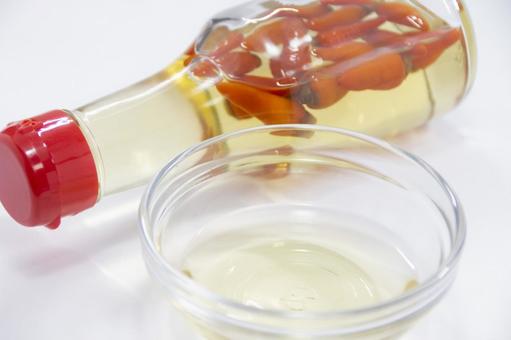
The Kanji for "bitter" is 苦, read in its 訓読み form as にがい (when being referred to as a flavor profile). It has an 音読み form, く, but it's not often used to describe flavor. Conjugated in, 苦い follows a similar pattern to all of the other flavor profiles, sans the 音読み:
苦い:にが・い:sweet (adjective)
苦さ:にが・さ:sweetness (noun)
苦味:にが・み:subjective level of bitterness (noun)*
苦み:にが・み:same meaning as 甘味, used more in casual conversation
The 苦 kanji takes on a different yet adjacent form when used as an emotional adjective, with its own 訓読み reading: くるしい. This means "to suffer" or "to experience hardship". Conjugated, it looks like this:
苦しい:くるし・い:painful; distressing; hard to do; unpleasant (adjective)
苦しむ:くるし・む:to suffer; to go through hardship; to worry (verb)
As much as we love a strong cup of black coffee, it's undoubtedly an acquired taste. In isolation, bitter doesn't have the most positive connotation, something that's very much reflected in its etymology. The same kanji for the bitter kick of an 85% cocoa black chocolate bar is used for the experience of going bankrupt or working a 70 hour day (never mind the math on that).
Bitter things get a bad wrap, but provided they don't cross the poison threshold, most of them are incredibly good for you. Bitter foods are often packed with nutrients and antioxidants. Bitter experiences almost always build character and make us more capable, well-adjusted human beings. Moreover, whether it's an ingredient in a recipe or a stretch of bad luck, 苦味 provides something that enhances all of life's flavors: contrast. Without にんにく to cut through it, that rich bowl of 豚骨ラーメン(とんこつらーめん)is nothing more than a fatty bowl of oil and salt. We need the rain and the grey to really feel the sun on our skin on those choice beautiful days. As they say, you gotta take the bitter with the better.
訓読み(くんよみ)
"kunyomi" – the native Japanese reading of a kanji
訓:くん:instruction; native Japanese reading
読・み:よ・み:reading
音読み(くんよみ)
"onyomi" – the Chinese-derived reading of a kanji
音:おん:sound
読・み:よ・み:reading
豚骨ラーメン(とんこつらーめん)
"tonkotsu ramen" – pork bone broth ramen
豚:とん:pork; pig
骨:こつ:bone; skeleton
With 苦味 as the 5th out of our 5 main flavor profiles, you should now have a decent enough understanding of what each different flavor profile does in a dish. To reiterate, these profiles are obviously NOT exclusive 和食, and part of the fun in cooking is exploring how different cultures have adapted different ingredients to feature each of these 5 flavors. Moreover, these articles merely scratched the surface of cooking.
By exploring the foundations of flavor through the lens of 和食, we can begin to work within the Japanese framework to become skilled at 味付け. Yet there are so many more variables that make 料理 as difficult as it is fun. Other subjects might include how to properly use fats and oils, how different aromatics change the way we taste the 5 flavor profiles, and of course, the complex role that heat and chemistry plays in developing both texture and flavor.
There's already a lot of great resources on these subjects out there, and we may explore them further in future articles. For now, just remember: cooking is supposed to be fun. No matter how delicious or disgusting your results turn out to be, it's all the testing and experimenting that's the most important part. Learning to be a good cook has a lot in common with becoming fluent in a new language. You try things out, you iterate, you fail, and things get confusing sometimes. But if you keep at it, combining different flavors in different ways, you'll learn how they coagulate together to form a fluid logic all their own.
Thanks for reading! Let us know in the comments section what you liked, what confused you, and what topics you'd like to see us expand on in the future, whether they're related to Japanese cooking, or language, or both!
味(あじ)
"aji" – flavor; taste
塩味(えんみ)
"enmi" – salty
塩:えん:salt
味:み:flavor; taste
甘味(かんみ)
"kanmi" – sweet
甘:かん:sweet
味:み:flavor; taste
酸味(さんみ)
"sanmi" – sour
酸:さん:acid
味:み:flavor; taste
旨味(うまみ)
"umami" – savory
旨:うま:savory; skilled; great
味:み:flavor; taste
苦味(にがみ)
"nigami" – bitter
苦:にが:bitter
味:み:flavor; taste
香り(かおり)
"kaori" – aromatic; fragrance
舌触り(したざわり)
"shita-zawari" – mouth feel; texture of a food
舌:した:tongue
触り:ざわり:to touch
料理(りょうり)
"ryōri" – cooking
料:りょう:materials; fee
理:り:logic; reason; arrangement
和食(わしょく)
"Washoku" – Japanese cuisine
和:わ:Japanese style; harmony
食:しょく:eat; food
味付け(あじつけ)
"aji-tsuke" – flavor development
味:あじ:flavor; taste
付け:つけ:to add; to join; to fix
調味料(ちょうみりょう)
"chō-mi-ryō" – condiments
調:ちょう:tune; tone; arrange
味:み:flavor; taste
料:りょう:materials; fee
量(りょう)
"ryō" – amount
濃・い(こ・い)
"koi" – strong; dark; potent
小皿(こざら)
"kozara" – small plate for dipping sauce
小:こ:small
皿:ざら:plate
焼き(やき)
"yaki" – grill (noun form)
焼・き:や・き
定食屋(ていしょくや)
定:てい:planned; determined
食:しょく:meal; food
屋:や:shop; seller; dealer
食材料(しょくざいりょう)
"shokuzai-ryō"– ingredients
食:しょく:food; eat
材:ざい:lumber
料:りょう:materials
炒め(いため)
"itame" – stir fry; saute (noun form)
台所(だいどころ)
"dai-dokoro" – kitchen
台:だい:pedestal; a stand; counter for machines
所:どころ:place
板(いた)
"ita" – board
柳刃包丁(やなぎばほうちょう)
"yanagi-ba hōchō" – special knife for cutting boneless sushi and sashimi
柳:やなぎ:willow
刃:ば:blade
"hōchō" – knife
包:ほう:wrap; conceal
丁:ちょう:tools; street; ward
ラーメン屋(らーめんや)
"ramen-ya" – a ramen restaurant
屋:や:shop; store; dealer
定食(ていしょく)
"teishoku" – set meal
定:てい:determined; decided
食:しょく:meal; eat
鍋(なべ)
"nabe" – pot; kettle
スーパー
"sūpā" – supermarket
お椀(おわん)
"o-wan" – small serving bowl
椀:わん:wooden bowl
生(なま)
"nama" – raw; life
食べ物(たべもの)
"tabemono" – food
食べ:たべ:food; eat
物:もの:thing; object
野菜(やさい)
"yasai" – vegetable
野:や:plains; field; rustic
菜:さい:vegetables; greens
果物(くだもの)
"kudamono" – fruit
果:くだ:fruit; reward
物:もの:thing; object
きゅうり *kanji very obscure and almost never used
"kyūri" – cucumber
動物(どうぶつ)
"dōbutsu" – animals
動:どう:move; motion
物:ぶつ:thing; object
肉(にく)
"niku" – meat; flesh
牛肉(ぎゅうにく)
"gyū niku" – beef
牛:ぎゅう:beef; cow
肉:にく:meat; flesh
鶏もも(とりもも)
"torimomo" – chicken thigh
鶏:とり:chicken
もも:thigh
玉子(たまご)
"tamago" – egg(s)
玉:たま:ball
子:ご:child; seed
卵焼き(たまごやき)
"tamago-yaki" – Japanese rolled omelette
卵:たまご:egg(s) *same meaning as 玉子, represented by one kanji
焼・き:や・き:to grill; to roast
刺身(さしみ)
"sashimi" – raw fish
刺:さ・し:pierce; stab
身:み:body
海鮮(かいせん)
"kaisen" – seafood
海:かい:ocean; sea
鮮:せん:fresh; vivid; clear; brilliant
ご飯(ごはん)
"gohan" – rice; meal
ご:御:honorific marker denoting something deserving of respect
飯:はん:meal; boiled rice
豚肉のしょうが焼き(ぶたにくのしょうがやき)
"buta-niku no shōgayaki" – stir-fried pork in ginger
豚肉(ぶたにく)
"buta niku" – pork
豚:ぶた:pork; pig
肉:にく:meat; flesh
しょうが(生姜)
"shōga" – ginger
しょう:生:raw; life
が:姜:ginger
海鮮(かいせん)
"kaisen" – seafood
海:かい:ocean; sea
鮮:せん:fresh; vivid; clear; brilliant
海鮮丼(かいせんどん)
"kaisen don" – bowl of seafood over rice
海:かい:ocean; sea
鮮:せん:fresh; vivid; clear; brilliant
丼:どん:bowl
ニンニク(にんにく、蒜)
"nin-niku" – garlic
フルーツ
"furūtsu" – fruit
*Alt. 果物(くだもの)
果:くだ:fruit; reward
物:もの:thing; object
乳製品(にゅうせいひん)
"nyū sei-hin" – dairy products
乳:にゅう:milk; breasts
製:せい:manufactured; made in...
品:ひん:goods
カリカリ
"kari kari" – crunchy
唐揚げ(からあげ)
"kara-age" – fried chicken
唐:から:T'ang, China
揚げ:あげ:fried
こってり
"kotteri" – thick; rich; heavy
豚骨ラーメン(とんこつらーめん)
"tonkotsu ramen" – pork bone broth ramen
豚:とん:pork; pig
骨:こつ:bone; skeleton
魚(さかな)
"sakana" – fish
寿司(すし)
"sushi" – anything made with vinegared rice
寿:す:longevity
司:し:director
酢飯(すめし)
酢:す:vinegar
飯:めし:meal; boiled rice
たれ(垂れ)
"tare" – sauce (particularly a mirin or soy-based sauce)
垂れ・る:たれ・る:to droop; to drip down; to hang down
おつまみ(お摘み)
"otsumami" – snack; side dish (eaten while drinking alcohol)
摘・む:つま・む: to pick; to pluck
しゃぶしゃぶ
"shabu shabu" – thinly sliced meat boiled with vegetables and dipping sauce
みそ汁(味噌しる)
"miso shiru" – miso soup
み:味:flavor; taste
そ:噌:robust
汁:しる:soup; juice
さけ(鮭)
"sake" – salmon
*often pronounced with a soft "sh" sound
さば(鯖)
"saba" – mackerel
まぐろ(鮪)
"maguro" – tuna
ぶり(鰤)
"buri" – Japanese amberjack (species of yellowtail)
ピーマン
"pīman" – green pepper
さつま芋(さつまいも)
"satsuma-imo" – Japanese sweet potato
芋:いも:potato
天ぷら(てんぷら)
"tenpura" – batter fried foods
天:てん:heavens; sky; imperial
青じそ(あお紫蘇)
"aojiso" – perilla leaves
青:あお:blue
紫:じ:purple
蘇:そ:revivded
*green and tasty – neither blue, nor purple, and certainly not revived
ねぎ
"negi" – onion
椎茸(しいたけ)
"shītake" – Japanese mushroom variant
椎:しい:oak; mallet
茸:たけ:mushroom
にら
"nira" – garlic chives
ゴーヤ(苦瓜(にがうり))
"goya" – bitter melon; bitter gourd
ハーブ
"hāb" – herbs
みょうが(茗荷)
"myōga" – Japanese ginger (Zingiber mioga)
みょう:茗:tea
が:荷:baggage; cargo
豆(まめ)
"mame" – beans; legumes
お茶(おちゃ)
"o'cha" – green tea
抹茶(まっちゃ)
"matcha" – powdered green tea
抹:まっ:rub; paint
茶:ちゃ:tea
お菓子(おかし)
"okashi" – confection; snacks
菓:か:fruit; candy; cakes
子:し:child
豆(まめ)
"mame" – beans; legumes
豆腐(とうふ)
"tōfu" – tofu
豆:とう:beans
腐:ふ:rot; decay
チャンプルー
"chanpurū" – Okinawan stir fry; (Okinawan for 'a mix of things')
塩(しお)
"shio" – salt
塩っぱ・い:しょっぱ・い:salty (adjective)
塩っぱ・さ:しょっぱ・さ:saltiness (noun)
塩味:えん・み:subjective level of saltiness (noun)
塩分(えんぶん)
"enbun" – salt content; The amount of sodium in a food
塩:えん:salt
分:ぶん:portion
醤油(しょうゆ)
"shōyu" – soy sauce
醤:しょう:a kind of miso
油:ゆ:oil
みそ(味噌)*primarily written in kana
"miso" – fermented soybean paste
み:味:flavor; taste
そ:噌:robust
赤味噌(あかみそ)
"aka miso" – red miso paste
赤:あか:red
味:み:flavor; taste
噌:そ:robust
甘い:あま・い:sweet (adjective)
甘さ:あま・さ:sweetness (noun)
甘味:かん・み:subjective level of sweetness (noun)*
甘み:あま・み:same meaning as 甘味, used more in casual conversation
みりん(味醂)*primarily written in kana
"mirin" – Japanese cooking wine
み:味:flavor; taste
りん:醂:bleach in water
砂糖(さとう)
"satō" – sugar
砂:さ:sand
糖:とう:sugar
糖分(とうぶん)
糖:とう:sugar
分:ぶん:portion
酒(さけ)
"sake" – Japanese rice wine
砂糖(さとう)
"satō" – sugar
砂:さ:sand
糖:とう:sugar
優しい(やさしい)
"yasashii" – gentle; kind
優し・い:やさし・い
蜂蜜(はちみつ)
"hachimitsu" – honey
蜂:はち:bee; wasp; hornet
蜜:みつ:honey; nectar
黒糖(こくとう)
"kokutō" – unrefined brown sugar
黒:こく:black
糖:とう:sugar
酸っぱい:すっぱ・い:sour; acidic (adjective)
酸っぱさ:すっぱ・さ:sourness; acidity (noun)
酸味:さん・み:subjective level of sourness (noun)*
酸っぱみ:すっぱ・み:same meaning as 酸味, used more in casual conversation
腐ってる(くさってる)
"kusatteru" – rotting; rotten
腐る:くさる:to rot; to go bad; to decay; to spoil
酒(さけ)
"sake" – Japanese rice wine
酸っぱい(すっぱい)
"suppai" – sour
梅干し(うめぼし)
"umeboshi" – pickled plum
干し:うめ:plum
干し:ぼし:dry; parch
漬け物(つけもの)
"tsukemono" – pickled foods
漬:つけ:pickling; soak
物:もの:thing; object
紅しょうが(べに生姜)
"beni shōga" – pickled red ginger
紅:べに:crimson; deep red
しょう:生:raw; life
が:姜:ginger
酢(す)
"su" – vinegar
柑橘(かんきつ)
"kankitsu" – citrus
柑:かん:citrus; orange
橘:きつ:mandarin orange
ポン酢(ぽんず)
"ponzu" – a citrus-based Japanese sauce similar to soy sauce
すだち
"sudachi" – a species of Japanese citrus, green in color
ゆず(柚子)
"yuzu" – a species of Japanese citrus, yellow in color
ゆ:柚:citron
ず:子:child
旨味(うまみ)
"umami" – savory; savoriness
旨:うま:delicious; skilled
味:み:flavor; taste
だし(出汁)
"dashi" – a Japanese broth made from fish and kelp
だ:出:to come out of
し:汁:soup; juice
上手い(うま・い)
"umai" – skilled; gracefull
上:up
手:hand
上手(じょうず)
"jōzu" – skilled; graceful
上:じょう:up; upper
手:ず:hand
美味い(うま・い)
"umai" – delicious
美:beautiful
味:flavor; taste
美味しい(おいし・い)
"oishii" – delicious
美:beautiful
味:flavor; taste
昆布(こんぶ)
"konbu" – edible Japanese kelp, usually dehydrated
昆:こん:descendants; insect
布:ぶ:linen; cloth
出汁(だし)
"dashi" – soup; broth
出・る:で・る:to give off, leave, or let out
汁:しる:soup, juice, or broth
つゆ
"tsuyu" – pre-made bottled broth
白だし(しろ出汁)
"shiro dashi" – white broth
白:しろ:white
だ:出:to come out of
し:汁:soup; broth
powdered fish stock, such as (NIBOSHI???))
味の素(あじのもと)
"Aji no Moto" – lit. "the beginning of flavor"; brand name for MSG establish by founder and scientist Dr. Kikunae Ikeda
味:あじ:
素:もと:
鰹節(かつおぶし)
"katsuo-bushi" – sliced dried bonito
鰹:かつお:bonito
節:ぶし:season; period; occasion
煮干し(にぼし)
"niboshi" – small dried sardines
煮:に:boil
干・し:ぼ・し:dried
苦い:にが・い:sweet (adjective)
苦さ:にが・さ:sweetness (noun)
苦味:にが・み:subjective level of bitterness (noun)*
苦み:にが・み:same meaning as 甘味, used more in casual conversation
苦しい:くるし・い:painful; distressing; hard to do; unpleasant (adjective)
苦しむ:くるし・む:to suffer; to go through hardship; to worry (verb)
苦い(にがい)
"nigai" – bitter
注意(ちゅうい)
"chūi" – CAUTION
注:ちゅう:concentration; notes; to pour into
意:い:idea; mind; thought
危険(きけん)
"kiken" – danger; hazard
危:き:dangerous; fear
険:けん:steep place; sharp eyes; precipitous
毒性(どくせい)
"dokusei" – toxic; poisonous
毒:どく:poison; germ
性:せい:essential nature; gender
辛味(からみ)
"karami" – spiciness (subjective)
辛:から:spicy
味:み:flavor
ゴーヤ(苦瓜(にがうり))
"goya" – bitter melon; bitter gourd
一味(いちみ)
"ichi-mi" – single pepper spice
一:いち:one
味:み:flavor; taste
七味(しちみ)
"shichi-mi" – blend of seven spices
七:しち:seven
味:み:flavor; taste
山椒(さんしょう)
"sanshō" – Japanese pepper (Zanthoxylum piperitum)
山:さん:mountain
椒:しょう:Zanthoxylum piperitum
わさび(山葵)
"wasabi" – wasabi (sometimes called "Japanese horseradish")
*these kanji have different readings when broken down
コーレーグス
"kōrēgusu" – Okinawan alcoholic pepper sauce
泡盛(あわもり)
"awamori" – strong Okinawan liquor
泡:あわ:bubble; foam
盛:もり:serving
辛い(からい)
"karai" – spicy
バター(ばたー)
"batā" – ...butter
加塩バター(かえんばたー)
"ka-en batā" – salted butter
加:か:add; join; include
塩:えん:salt
無塩バター(むえんばたー)
"mu-en batā" – unsalted butter
無:む:nothing; none; void
塩:えん:salt
胡麻油(ごまあぶら)
"goma-abura" – sesame oil
胡:ご:foreign; barbarian
麻:ま:hem; flax
油:あぶら:oil
栄養(えいよう)
"eiyō" – nutrition; nutrients
栄:えい:flourish; prosperity
養:よう:foster; bring up; rear
炭水化物(たんすいかぶつ)
"tansui-kabutsu" – carbohydrates
炭:たん:charcoal
水:すい:water
化:か:change; take the form of
物:ぶつ:thing; object
蛋白質(たんぱくしつ)
"tanpaku-shitsu" – protein
蛋:たん:egg white
白:ぱく:white
質:しつ:substance; quality
脂肪質(しぼうしつ)
"shibō-shitsu" – fat
脂:し:fat; grease; lard
肪:ぼう:obese; fat
質:しつ:substance; quality
塩分(えんぶん)
"enbun" – sodium content
塩:えん:salt
分:ぶん:portion
糖分(とうぶん)
糖:とう:sugar
分:ぶん:portion
電解質(でんかいしつ)
"denkaishitsu" – electrolytes
電:でん:electricity
解:かい:unravel; untie; solve
質:しつ:substance; quality; matter
毒性(どくせい)
"dokusei" – toxic; poisonous
毒:どく:poison; germ
性:せい:essential nature; gender
豆(まめ)
"mame" – beans; legumes
お茶(おちゃ)
"o'cha" – green tea
栄養(えいよう)
"eiyō" – nutrition; nutrients
栄:えい:flourish; prosperity
養:よう:foster; bring up; rear
ビタミン
"bitamin" – vitamins
成分(せいぶん)
"seibun" – component; ingredient; (essential items)
成:せい:to become
分:ぶん:part; portion
抗酸化物質(こうさんかぶっしつ)
"kōsan kabu-shitsu" – antioxidants
抗:こう:confront; resist; defy; oppose
酸:さん:acid; sour
化:か:change; take the form of
物:ぶつ:thing; object
質:しつ:substance; quality; matter
栄養学(えいようがく)
"eiyo gaku" – nutritional science
栄:えい:flourish; prosperity
養:よう:foster; bring up; rear
学:がく:study; learning
訓読み(くんよみ)
"kunyomi" – the native Japanese reading of a kanji
訓:くん:instruction; native Japanese reading
読・み:よ・み:reading
音読み(くんよみ)
"onyomi" – the Chinese-derived reading of a kanji
音:おん:sound
読・み:よ・み:reading
国(くに)
"kuni" – country
王(おう)
"ō" – king
総理大臣(そうりだいじん)
"sōridaijin" – prime minister
総:そう:whole; all; general
理:り:logic; reason; arrangement
大:だい:big; large
臣:じん:retainer; minister; subject
築地(つきじ)
"Tsukiji" – site of Tokyo's former wholesale fish market
築:つき:fabricate; build
地:じ:ground; earth
*literally translates to "reclaimed land"
豊洲(とよす)
"Toyosu" – site of Tokyo's current wholesale fish market
豊:とよ:bountiful; abundant
洲:す:continent; sandbar; country
東京(とうきょう)
"Tōkyō" – Yes, the Tōkyō: Japan's capital
東:とう:east
京:きょう:capital
通訳者(つうやくしゃ)
"tsūyaku-sha" – interpreter
通:つう:pass through; lead to; avenue
訳:やく:translate; reason
者:しゃ:person
市場(いちば )
"ichiba" – marketplace
市:いち:market; city; town
場:ば:location; place
仲卸業者(なかおろしぎょうしゃ)
"naka-oroshi gyō-sha" – wholesalers of seafood, particularly tuna
仲:なか:relationship; go-between
卸:おろし:wholesale
業:ぎょう:business; vocation
者:しゃ:person
つまらない(詰まらない)
"tsumaranai" – boring
詰・る:つま・る:to be packed; to be full
*yep, the kanji is one of those weird ones us non-natives don't understand
世界(せかい)
"sekai" – the world; society; the universe
世:せ:society; world
世:かい:world
伝統(でんとう)
"dentō" – tradition
伝:でん:transmit; walk along; report
統:とう:overall; relationship
温泉(おんせん)
"onsen" – natural hot spring
温:おん:warm
泉:せん:spring; fountain
天国(てんごく)
"tengoku" – heaven
天:てん:heaven
国:ごく:country; nation
お化け(おばけ)
"obake" – monster
化け:ばけ:transforming; to take another form
日本人(にほんじん)
"nihon-jin" – Japanese person; Japanese national
日:に:day; sun; Japan
本:ほん:book; main; true
人:じん:person
お湯(おゆ)
"oyu" – hot water; bath
科学(かがく)
"kagaku" – science
科:か:department; course
学:がく:study; learning
偽物(にせもの)
"nisemono" – fake; imposter
偽:にせ:false
物:もの:thing
沖縄(おきなわ)
"Okinawa" (Japan's most southwestern prefecture / island chain)
沖:おき:open sea
縄:なわ:straw rope; cord
Did you like this article? Please share it around!
Tags
food
Never miss a post – let us slide into your inbox with hot articles.
Session expired
Please log in again. The login page will open in a new tab. After logging in you can close it and return to this page.